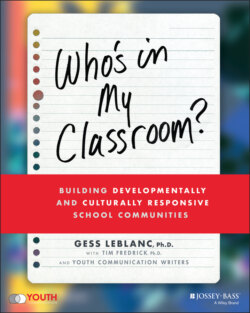Читать книгу Who's In My Classroom? - Tim Fredrick - Страница 18
Becoming a Developmentally and Culturally Responsive Teacher
ОглавлениеSo what makes teachers developmentally and culturally responsive? In my work, I've found that developmentally and culturally responsive teaching is demonstrated when teachers design and implement lessons that engage students intellectually in a supportive and nurturing environment that values them as assets. You can see it in the learning experiences described by the students in this chapter, and you'll see more throughout this book.
Developmentally and culturally responsive teachers have a basic understanding of the developmental sciences, which we've briefly reviewed in this book. Study and experience help them also understand the characteristics of cognitive, physical, linguistic, social, and emotional development that are typical of students within the age ranges they teach.
Developmentally and culturally responsive teachers also model empathy and care and make connections with students by purposefully seeking to learn about them, their families, and how they've navigated life both inside and outside of school.
I've also found that developmentally and culturally responsive teachers have certain “habits of mind” that shape how they plan and implement lessons. For example, they acknowledge and question their beliefs and expectations about all children and particularly children from backgrounds different from their own. In developing their lessons, they also draw on their knowledge of children's cultural backgrounds and experiences outside of school. They view children's experiences outside of school as sources of strength that can positively contribute to school performance. They see their lessons as opportunities to foster their students’ motivation and belief in their ability to succeed in school.
Ultimately, as Zaretta Hammond noted in her book Culturally Responsive Teaching and the Brain,32 developmentally and culturally responsive teaching is “not a practice” but what “informs our practice” by enabling teachers to meet the developmental needs of children in culturally responsive ways.
Finally, here's a paradox. Having greater knowledge of the cultural backgrounds of your students isn't a prerequisite for being developmentally and culturally responsive. It's mostly a consequence of it. When we think of this knowledge as a prerequisite, it suggests that we can't teach in a developmentally and culturally responsive way until after we've acquired that knowledge. As we noted earlier, that can paralyze teachers. If you teach in a reasonably diverse school, just learning about the religions and home foods of your students could take months of study. Another problem is that teachers can treat getting to know their students as a one-off exercise in extracting information. I've seen teachers lead activities to quickly get to know their students at the beginning of the school year, but fail to sustain the discussion and curiosity throughout the year—or worse, use the information to form settled judgments about students. That can lead to surface-level and even stereotypical and biased perspectives of students. However, when we view this knowledge more as a consequence, then we focus on how we can employ developmentally and culturally responsive practices in an intentional and consistent way over time.
